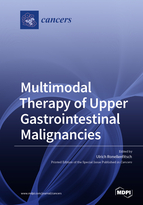Multimodal Therapy of Upper Gastrointestinal Malignancies
A special issue of Cancers (ISSN 2072-6694). This special issue belongs to the section "Cancer Therapy".
Deadline for manuscript submissions: closed (31 October 2020) | Viewed by 46859
Special Issue Editor
Interests: upper gastrointestinal cancer; multimodal treatment; gastrectomy; esophagectomy; sarcoma; quality of care; meta-analysis
Special Issues, Collections and Topics in MDPI journals
Special Issue Information
Dear Colleagues,
Recent decades have seen remarkable advances in the treatment of upper gastrointestinal malignancies, i.e., adenocarcinoma and squamous cell carcinoma as well as gastrointestinal stromal and other rare tumors of the esophagus and stomach. While, historically, surgical resection has been the sole treatment for these tumors, multimodal therapies have meanwhile proven their efficacy. At present, pre- and postoperative chemotherapy and radiotherapy, targeted drug therapy, and stage-specific surgical approaches are all indispensable cornerstones of an individualized treatment for upper gastrointestinal malignancies. With such multimodal treatment, better outcomes comprising improved quality of life and prolonged survival have been achieved for patients. However, for many tumor entities and stages, the ideal combination and sequence of treatments is still being evaluated in clinical trials. Moreover, the value of novel approaches such as immunotherapy or robotic surgery remains a matter of research.
In this Special Issue of Cancers, up-to-date original research, short communications, and comprehensive review articles on all modalities playing a role in the treatment of upper gastrointestinal malignancies will be published. Moreover, the results of preclinical studies with implications on treatment also qualify for publication.
Prof. Dr. Ulrich Ronellenfitsch
Guest Editor
Manuscript Submission Information
Manuscripts should be submitted online at www.mdpi.com by registering and logging in to this website. Once you are registered, click here to go to the submission form. Manuscripts can be submitted until the deadline. All submissions that pass pre-check are peer-reviewed. Accepted papers will be published continuously in the journal (as soon as accepted) and will be listed together on the special issue website. Research articles, review articles as well as short communications are invited. For planned papers, a title and short abstract (about 100 words) can be sent to the Editorial Office for announcement on this website.
Submitted manuscripts should not have been published previously, nor be under consideration for publication elsewhere (except conference proceedings papers). All manuscripts are thoroughly refereed through a single-blind peer-review process. A guide for authors and other relevant information for submission of manuscripts is available on the Instructions for Authors page. Cancers is an international peer-reviewed open access semimonthly journal published by MDPI.
Please visit the Instructions for Authors page before submitting a manuscript. The Article Processing Charge (APC) for publication in this open access journal is 2900 CHF (Swiss Francs). Submitted papers should be well formatted and use good English. Authors may use MDPI's English editing service prior to publication or during author revisions.
Keywords
- upper gastrointestinal cancer
- multimodal treatment
- chemotherapy
- radiotherapy
- surgery
- immunotherapy
- targeted therapy







